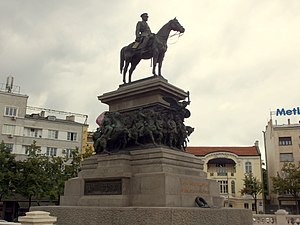Battle of Sofia
| Battle of Sofia | |||||||
|---|---|---|---|---|---|---|---|
| Part of Russo-Turkish War (1877-1878) | |||||||
 The Monument to the Tsar Liberator in Sofia |
|||||||
|
|||||||
| Belligerents | |||||||
|
|
|
||||||
| Commanders and leaders | |||||||
|
|
|
||||||
| Units involved | |||||||
| Gurko's Western Squad | Orkhanie Army | ||||||
The Battle of Sofia (Bulgarian: Битката при София) was the final action of Russian Lt Gen Iosif Gurko's Gurko's Western Squad for the defeat of the Orkhanie army in the Russo-Turkish War (1877-1878). It led to the Liberation of Sofia from Turkish rule.
The Battle of Sofia is the culmination of the West group Gurko defeating the Orkhanie Ottoman army in the Russo-Turkish War (1877–1878). It ends with liberating Sofia from Ottoman rule.
In early January 1877, the West army group Gurko successfully crossed the Balkan Mountains. Parts of the group was to focus on Yana village. The Orkhanie Ottoman army after the Battle of Tashkessen retired to the Sofia area. Western group Gurko passed to operation Orkhanie to defeat the Ottoman army, according to the plan for final action in the war. General Iosif Gurko said: "Probably we would not have crossed the mountain, were it not for these silent and strong Bulgarians who brought us bread and hot food. They prompted us to remove the horses to harness their oxen to the guns and so went the first party to pass through snowdrifts and freezing cold."
Part of the forces of the West group Gurko with 20,000 soldiers and 46 cannons commanded by Major General Otto Rauch were directed into Sofia field. They were grouped into two columns: the right column of Lieutenant General Nikolai Velyaminov attacked from the north, and the left column of Major General Otto Rauch from the east. The opponent was Sofia's Ottoman holding force, 15,000 soldiers under Commander Osman Nuri Pasha, who occupied the approaches to the city and fortifications around the city.
On 19/31 December Ottoman forces (5000 soldiers) were directed against the column of Lieutenant Velyaminov (4200 soldiers). The Ottomans burned Dolni Bogrov and Botunets villages. This led to a gun battle. The next day, December 20 / January 1, attacking frontally, they made two attacks and attempt to attack the Russian flanks. After Russian counterattack the opponents abandoned Dolni Bogrov and by nightfall fled and were pursued.
...
Wikipedia
